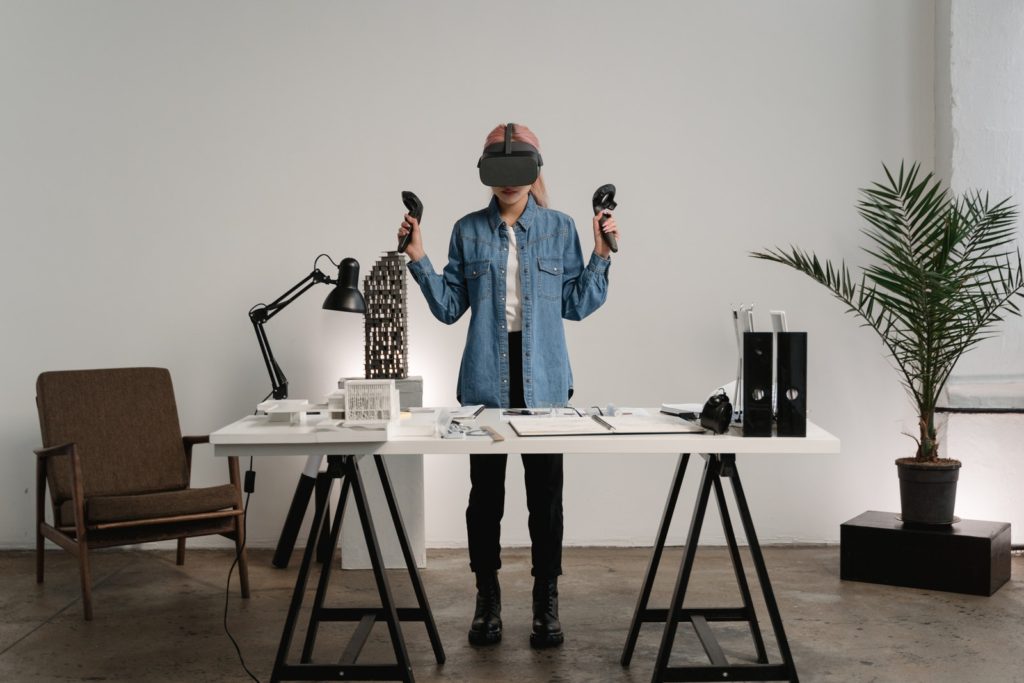There’s an inescapable disconnect between businesses and consumers right now when it comes to augmented reality. Seventy-one percent of consumers said that they would shop more often with a brand that promotes augmented reality. Meanwhile, only one percent of retailers use AR as part of the buying experience.
That sounds like an opportunity!
In this article, we’ll look at how to use augmented reality for marketing, the benefits of augmented reality, and how augmented reality will affect the future of marketing. Most importantly, we’ll discuss ten fantastic ways to integrate AR into your business marketing strategy today.

What Are the Benefits of Augmented Reality?
AR is, as a concept, still in its infancy. However, most people, especially the more technically inclined, understand that they can see the world differently through their mobile phones.
166 million Pokémon Go players globally, along with 500 million monthly active users on Snapchat, ensures surprisingly high levels of mainstream awareness.
However, neither app helps to dispel the view of AR as something for games and novelties. Instead, it’s reflected in that statistical disconnect mentioned above. It’s a rare case of consumers being more aware of the potential than the vendors that serve them.
And therein lies the opportunity.
The benefits of augmented reality extend far beyond bunny ears and Pikachus:
1. Augmented Reality Suits Online Shopping
People don’t shop like they used to. An increasing number of your potential customers question why they would spend a day at the mall when they can have something delivered.
All that’s missing are the fitting rooms and seeing things for yourself. However, AR overcomes that to a substantial degree. From hairstyles and clothing to augmenting your living room with virtual furniture like IKEA, it’s ‘try before you buy’ for the Amazon Prime generation.
AR lets you show customers what to expect if your business delivers, blurring the line between physical and digital.
2. It Makes the World Around Us More Informative
If you can remember navigating roads with paper directions, Google Maps must feel like a revolution. Augmented reality takes this to the next level.
We have access to more information today than humans at any point in history. AR makes it relevant.
Do you need real-time translation? No problem. If you want directions superimposed over the real world, Google Maps has you covered.
If you’re a retailer, your customers can use AR in your store to go beyond what’s on the shelves. They can see color options, sizes, delivery dates, and anything else you want to engage them with through an AR lens.
3. You Can Be There When You’re Not
A certain global pandemic reminded people how important it can be to experience things for themselves.
Sometimes, life gets in the way, and you can’t always be there for real. However, augmented reality can bring you closer.
StubHub used augmented reality for Super Bowl LII, allowing prospective ticket buyers to see how the US Bank Stadium experience played out. If you’re into performing arts but don’t fancy traveling to Washington, your can tour the Kennedy Center in augmented reality.
From office tours to walking around your store, AR can bring potential customers from thousands of miles away to your doorstep.
4. Your Customers and Clients Want to Engage
Augmented reality and marketing go hand in hand for one simple reason and through the most significant benefit of all. When augmented reality is involved, customers want to be sold to.
In a marketing landscape where streaming has desensitized people to TV commercials, and 41.3 percent of Canadian internet users use an ad blocker online, AR stands tall.
Augmented reality marketing adds value in any sector. Consumers don’t feel like they’re the product as they do with conventional advertising.
The IKEA example above is fantastic to illustrate this point. The Swedish furniture maker utilized their first-mover advantage to show people how a sofa would look in their front room or a table in their dining room.
People use the app to dream and plan, and to design their perfect home, live and in living color. But, whether they’re ready to buy or not, when the time comes to fulfill those dreams, where do they go to make their furniture dreams happen?
How To Use Augmented Reality for Marketing Today
Time is of the essence. No matter your industry, there’s a great chance you’ll be the first to adopt AR for your business.

First-mover advantage doesn’t always apply as it did for IKEA. Google wasn’t the first search engine, but Amazon was the first online bookstore.
In most cases, it’s better to be first than second in business. With extended reality already changing the world, AR could represent a once-in-a-lifetime opportunity for your brand.
Of course, there’s only ever one first-mover, so here are ten ways to add augmented reality into your business marketing strategy without delay.
1. Get Your Online Retail Products AR Ready
Cart abandonment has plagued e-commerce since the last century. For every 100 prospective customers that start a cart, 70 won’t complete the purchase.
Some customers are just browsing.
Others were daydreaming.
A significant number simply wasn’t quite ready to commit. These are the ones you want to engage with augmented reality.
Think about the doubts they may have had in mind.
If you sell clothes, would an item fit correctly? Would the color suit them?
If you sell experiences, from escape rooms to outdoor adventures, what’s it like to be there?
Nobody knows your products and customers as you do. So use that expertise – and a dash of AR – to respond to queries not with words in emails and chat boxes but by extending their reality.
2. Spread Some Joy
We all know the value of a happy customer, but how about a happy prospective customer? Even a brief moment of enjoyment can create lasting positive sentiment.
While already a household name, USPS used this technique to perfection. Their AR app launched in 2014, and it sprang to life around Christmas, with 2016’s effort being notable for animated messages on physical mail.
Once again, it was all about blurring the lines between the virtual and physical worlds.
Your business could follow that lead with scannable codes on festive shipments. If you have a company mascot, it could come to life in someone’s home.
What would make your target audience happy, and what can AR do to help?
3. Inform Your Audience
Millions of schoolchildren around the globe might disagree, but people love to learn things — the more unusual, exciting, or downright shocking, the better.
Education uses AR to enhance the learning experience, but you don’t need to be a teacher to get involved.
The WWF’s Free Rivers app lets users superimpose entire landscapes on their desks. From there, they educate, inform and spread their message of sustainability.
You might be in a position to inform your users about your company and products directly. If not, add a twist — talk about your own environmental efforts or showcase the unique parts of the manufacturing process.
4. Extend Your App – Or Build a New One
Apps haven’t yet reached the critical mass we saw with websites around the turn of the century, where every business had to have one. However, while mobile websites might do for your competitors, AR often means dedicated apps — and all the benefits that go with it.
With our expert extended reality app development, you’ll enjoy:
- Seamless integration of current and future AR projects
- Complete control over how your content is displayed
- A long-term branded home on your audience’s device
AR can be the hook, but there are limitless possibilities to where you can take your app next.
5. Build a Buzz and Go Viral
Much to the chagrin of marketers over the world, ‘going viral’ isn’t an exact science. However, creating something unique and cool is often a great starting point.
Take the Pokémon Go example. Sure, that franchise has plenty of fans, but consider the people you know who played it. They didn’t watch the show or collect the cards, but they loved the novelty of cartoon monsters in the street.
AR is still youthful enough that there’s still time to create something somewhat related to your brand that’s never been seen or done before.
It doesn’t even need to impact the bottom line immediately directly. Don’t underestimate the value of someone having heard your name before when closing the deal, even if they can’t remember where!
6. Add Value
Consumers are open to AR marketing because it enhances their experience. If you can solve a problem or educate, they won’t mind your branding.
If you sell tools, you could draw inspiration from Apple’s AR measuring app.
If you sell complex machinery, your AR app could open the relevant part of the user guide on screen when the camera focuses on a specific area – something that covers everything from cars to 3D printers.
In short, create something that makes lives easier and that your competitors aren’t doing.
7. Catch People Off Guard
It’s harder than ever to achieve true shock value, especially with people making entire careers from YouTube prank shows.
Pepsi managed to achieve it with AR when they modified a bus shelter.
Augmented reality can literally alter someone’s worldview, so there’s no reason not to. Plus, if you can get them talking, you’re a step closer to the ‘going viral’ part of the plan!
8. Capitalize on What Already Makes You Special
You might not be starting from scratch. You may already have a well-known brand or at least a few of the components.
Many different assets make sense for AR.
It could be your company logo springing to life through animation. If it happens to be an animal, it could start walking around someone’s house.
You might have a company video that’s already well-loved among your audience. You could use AR to make it even more immersive or create a dedicated AR spinoff as Netflix did with Stranger Things.
9. Promote Personalization
What’s one sure-fire way to step ahead of the competition? Personalizing your products — and AR can help.
Shoppers love something uniquely theirs, and they’re happy to go with premium products to do so. That’s why Apple’s engraving service is so popular.
Nike is a likely example. Their AR efforts extend solely to improving shoe size measurement at the time of writing but combining AR with Nike By You feels almost inevitable.
10. Don’t Neglect the Traditional Marketing Mix
Augmented reality and indeed extended reality as a whole is hugely exciting for marketers. There are clear benefits to moving fast, but that doesn’t mean forgetting what got your brand to where it is today.
AR isn’t there to replace other marketing efforts. Instead, just as with your products and services, it should enhance them.
Consider how AR and QR codes can interact with your business. Update your ads to show a different perspective.
Where there are cameras and screens, there’s scope for augmented reality.
How Will Augmented Reality Affect the Future of Marketing?
It’s easy to feel like the future is now in terms of AR and marketing, but even the most prominent brands have barely scratched the surface of what’s possible.
Once again, the key to the future is how augmented reality changes perceptions, not only in the conventional sense but also in marketing terms.

In a world where consumers go out of their way to avoid being marketed to in many traditional senses, augmented reality enables brands of all sizes to treat their audience as more than just walking wallets.
Shoppers expect more in return for being marketed to. Extended reality can achieve this through:
- Bringing back the personal touch to business dealings, even with global audiences
- Providing tools and solving problems to make life easier
- Transforming marketing from an event to an experience
AR and the Metaverse
No observation of AR and the future of marketing would be complete without mentioning the metaverse.
It’s impossible to say how the whole metaverse idea will play out in the coming years. However, if that’s where people start spending their time, you can bet that’s where the marketing will be.
The world’s eleventh most valuable company (as of February 2022) wouldn’t have changed its name to Meta without big plans.
They were already heavily exposed to the extended reality space and virtual reality, specifically following the 2014 acquisition of Oculus.
If the metaverse expands as some predict, that first-mover advantage will become even more valuable.
Given the undoubted importance of extended reality technologies to metaverse marketing, there’s no reason not to get a head start — especially when the technology is already so relevant to the real, non-metaverse.

Start Your Journey Into AR Marketing with Aequilibrium
Whether you already have your AR marketing strategy sketched out, have a couple of unique ideas, or want expert insight with your specific brand in mind, we’d be delighted to tell you more.
So, if you’re wondering how to use augmented reality for marketing, the first step is getting started!
We create extended reality apps and software for all business functions with a passion for what emerging technologies can do to take brands to the next level.
Get in touch to discover how we can do that for you.




